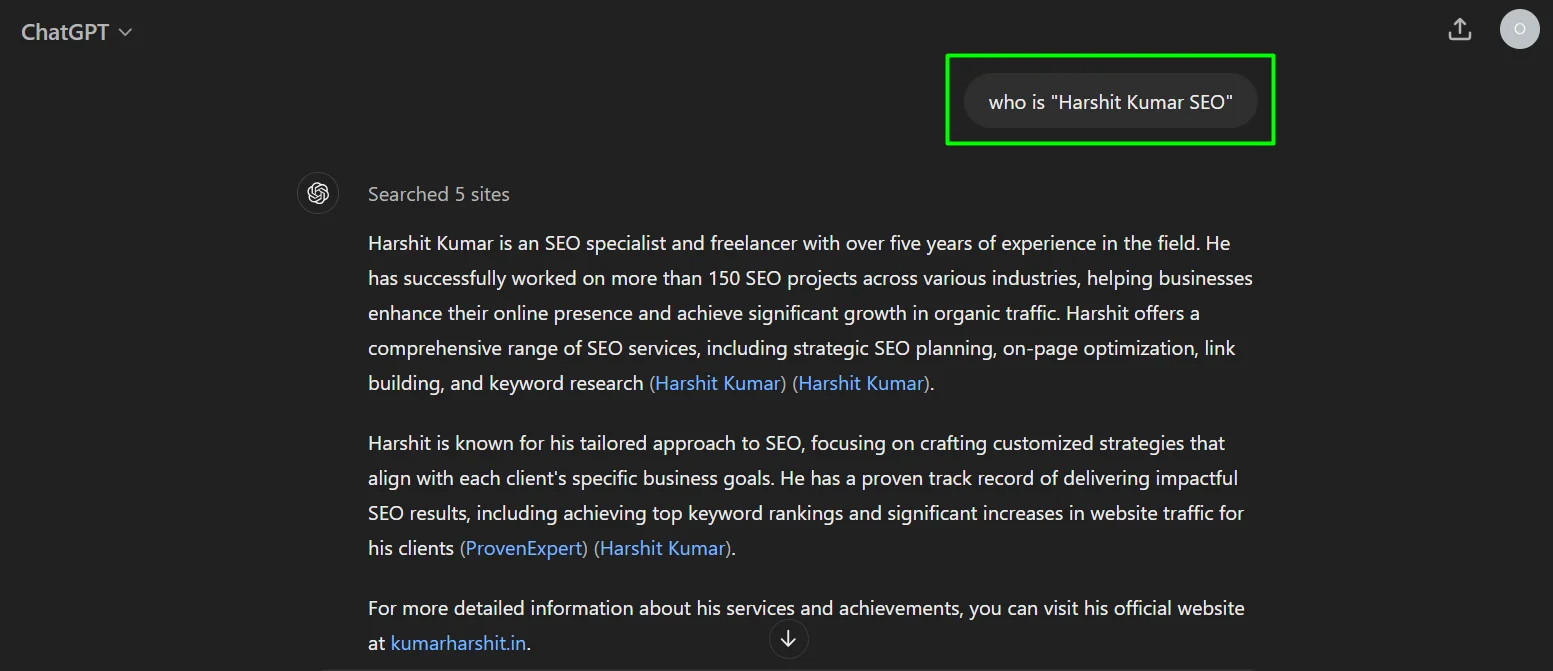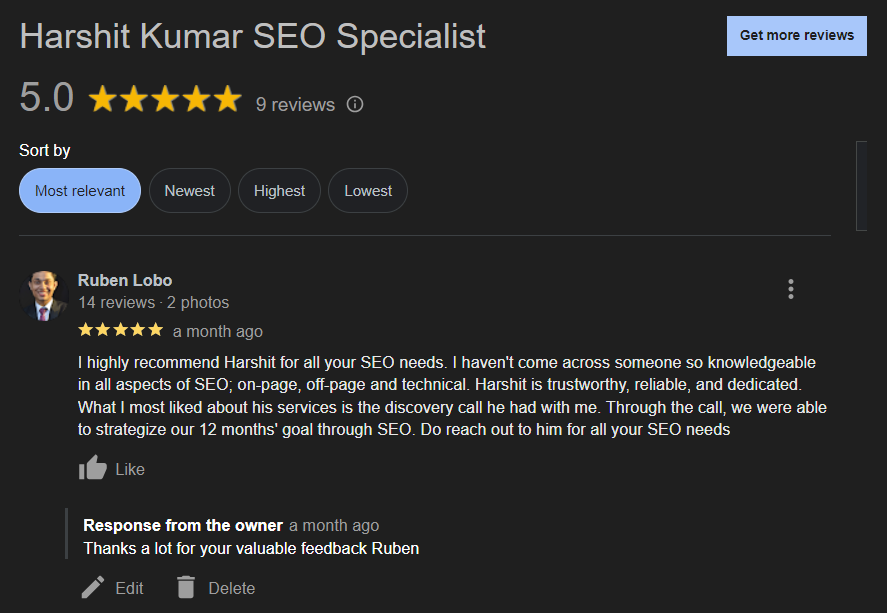Transform Your Business with AI-Powered SEO
Future-proof your online presence with cutting-edge AI SEO strategies that get your brand featured in ChatGPT, Google AI Overview, and next-generation search platforms.

How AI Sees the Best AI SEO Specialist
Why Harshit Kumar is The Best AI SEO Specialist
AI-First Approach
I pioneered AI-first SEO strategies that ensure your brand appears as the authoritative answer in ChatGPT, Gemini, Google AI Overview, and other AI-powered search systems.
Proven Results
With over 150+ successful AI SEO campaigns, I've helped businesses achieve dramatic growth in brand visibility, trust, and leads using ethical, transparent strategies.
Cutting-Edge Methods
I use proprietary micro-proof publication methods, entity-based brand building, and prompt-driven content structuring to future-proof your SEO strategy.
Risk-Free Guarantee
With my unique Pay Later SEO model, you only pay when your keywords rank and your AI visibility improves. No results, no payment.
Real AI SEO Case Study
How I achieved 1452% growth in visibility across Google AI Overview, ChatGPT, Grok, and traditional SERPs within few days of strategic work.
The Challenge
Before April 2024, despite strong SEO foundation, the personal brand site was receiving low visibility in AI-driven search systems and only 1,566 impressions with 23 clicks in Google Search Console.

The Strategy
- Content optimization with E-E-A-T focus
- Advanced schema markup implementation
- High-quality backlink strategy
- Technical SEO enhancements

Key Takeaway: This case study proves that with the right combination of content optimization, schema markup, and strategic backlinks, even personal brand websites can dominate across multiple AI search platforms.
AI & Search Visibility Success Stories




Why Businesses Trust Harshit Kumar for AI SEO
With 7+ years of SEO mastery and a deep focus on AI-first platforms, Harshit Kumar is helping brands appear where it matters most — in AI answers, not just search results.
- 🚀 AI-First Optimization: Every campaign is designed for ChatGPT, Google AI Overview, Gemini, Grok, and similar engines.
- 📊 1452% Visibility Growth: Harshit's AI SEO methods have delivered breakthrough ranking improvements in record time.
- 🧠 Entity + Schema Strategy: Implementation of structured data, entities, and prompt-ready content to signal trust to LLMs.
- 🔗 Smart Internal Linking: Creator of the “Advance SEO Internal Linking” WordPress plugin used to automate AI-aware link placement.
- 💼 Trusted by 150+ Brands: Across SaaS, eCommerce, education, health, and more.
- 💰 Pay Later SEO Model: Results-first approach — pay only after improvement in rankings and AI visibility.

Comprehensive AI SEO Solutions
Technical & On-Page SEO
- Comprehensive SEO Audit & Analysis
- AI-Optimized Schema Markup
- Core Web Vitals Optimization
- WordPress & WooCommerce SEO
- Advanced Analytics Setup
AI Content Strategy
- Prompt-Based Content Structuring
- Entity-Focused Keyword Research
- AI-First Copywriting & Blogging
- Semantic SEO Optimization
- Content for AI Tools
Authority Building
- High-Quality Backlink Building
- Google Business Profile Optimization
- Reputation Management
- Press Release Distribution
- Strategic Outreach Campaigns
Sectors I Specialize In
E-commerce
Boost product visibility, organic traffic, and sales through AI-optimized SEO strategies for online stores.
SaaS & Tech
Enhance software product discovery and user acquisition with technical SEO and content marketing.
Healthcare
Build trust and authority in medical fields while ensuring compliance with healthcare regulations.
Education
Drive enrollment and engagement for educational institutions and online learning platforms.
Real Estate
Increase property visibility and lead generation through local and geo-targeted SEO strategies.
Finance
Build financial authority and trust while navigating complex regulatory compliance requirements.
Automotive
Drive dealership traffic and automotive service visibility through targeted local SEO campaigns.
Global Business
Scale international reach with multilingual SEO and global market penetration strategies.
Watch Me Featured in AI Search Results
See real proof of how I appear in AI-powered search engines and tools. These videos show live results from major AI platforms.
Google AI Overview Results
See how Harshit Kumar appears as the top AI SEO specialist in Google's AI Overview feature.
ChatGPT Recognition
Watch live search results showing Harshit Kumar being featured in ChatGPT responses.
Microsoft Copilot Results
Real-time demonstration of appearing in Microsoft Copilot AI search results.
Grok AI Recognition
Live proof of being featured in Grok (X/Twitter's AI) search results for AI SEO specialist queries.
Choose Your Success Plan
Basic SEO Plan
per month
- Up to 20 Keywords
- On-Page SEO: Up to 10 Pages
- Off-Page SEO (Backlinks)
- Monthly SEO Reporting
- Technical Optimization
- Google Analytics Setup
- Search Console Integration
- Google Tag Manager Setup
- WhatsApp Chat Support
Advanced SEO Plan
per month
- Up to 50 Keywords
- On-Page SEO: Up to 20 Pages
- Technical Optimization
- Off-Page SEO (Backlinks)
- Bi-Monthly SEO Reporting
- 2 Web Blogs Per Month (600X2 Words)
- Google Business Profile Creation
- 2 GMB Post Per Month
- WhatsApp Chat Support
Premium SEO Plan
per month
- Up to 100 Keywords
- On-Page SEO: Up to 40 Pages
- Technical Optimization
- Off-Page (Backlinks)
- Weekly SEO Reporting
- 5 Web Blogs Per Month (1000X5 Words)
- Google Business Profile Creation
- 5 GMB Post Per Month
- WhatsApp Chat Support
Basic Pay Later
one-time for 6 months
- Up to 20 Keywords
- On-Page SEO: Up to 10 Pages
- Off-Page SEO (Backlinks)
- Full SEO Audit with Competitor Analysis
- Pay based on keyword ranking performance
- Monthly Ranking & Analytics Reports
- 24x7 Email & WhatsApp Support
Advanced Pay Later
one-time for 6 months
- Up to 50 Keywords
- On-Page SEO: Up to 20 Pages
- Off-Page SEO (Backlinks)
- Includes all Basic Plan features
- Pay based on keyword ranking
- Price capping option available
- Priority Email & WhatsApp Support
Premium Pay Later
one-time for 6 months
- Up to 100 Keywords
- On-Page SEO: Up to 40 Pages
- Off-Page SEO (Backlinks)
- Includes all Advanced Plan features
- Save 62.1% compared to monthly plans until rankings improve
- Pay Only When Keywords Rank
- 24x7 Priority Email, WhatsApp, & Live Support
Monthly vs Pay Later SEO Plans
| SEO Plan | Monthly SEO Plan | Pay Later SEO Plan |
|---|---|---|
| Payment Frequency | Monthly (e.g., $1,100 per month) | One-time advance payment ($2,500 for 6 months) |
| Total Cost for 6 Months | $6,600 ($1,100 x 6) | $2,500 (equivalent to $416.66/month) |
| Savings | ✗ No savings | ✓ 62.1% savings until ranking |
| Risk | ✓ Fixed monthly cost regardless of ranking | ✓ Pay only when rankings improve |
| Capping Limit | ✗ Not available | ✓ Set a max cap (e.g., $1,100 per month) |
- • If you choose a monthly SEO plan, you will need to make payments every month. For example, if you select the Premium SEO Plan, the cost for 6 months will be $1,100 x 6 = $6,600.
- • However, with the Pay Later SEO Plan for the same Premium SEO package, your total cost for 6 months will be $2,500—which comes down to $416.66 per month. This means you save 62.1% until your keywords start ranking.
- • Additionally, we offer a capping limit feature with the Pay Later Plan, allowing you to set a maximum monthly payment cap. For example, you can decide, "I will not pay more than $1,100 per month, even if all my keywords rank." This ensures better budget control and prevents unexpected expenses, making it a cost-effective and risk-free SEO solution.
What My Clients Say

"Harshit Kumar's AI SEO techniques revolutionized our organic reach and visibility. We saw immediate improvements in rankings on Google and AI platforms."

"Thanks to Harshit's AI-first SEO approach, our site now appears as featured answers in ChatGPT and Google AI responses."

"Professional, result-oriented, and innovative — Harshit Kumar is the AI SEO Specialist to trust for future visibility."
Frequently Asked Questions
Ready to Transform Your SEO Strategy?
Copyright © 2025 KumarHarshit.In | Refer & Earn | Powered by Harshit Kumar | Please Read T&C and Privacy Policy
Chat Now